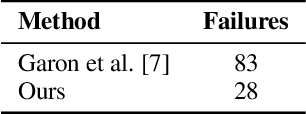Etienne Dubeau
RGB-D-E: Event Camera Calibration for Fast 6-DOF Object Tracking
Jun 09, 2020



Abstract:Augmented reality devices require multiple sensors to perform various tasks such as localization and tracking. Currently, popular cameras are mostly frame-based (e.g. RGB and Depth) which impose a high data bandwidth and power usage. With the necessity for low power and more responsive augmented reality systems, using solely frame-based sensors imposes limits to the various algorithms that needs high frequency data from the environement. As such, event-based sensors have become increasingly popular due to their low power, bandwidth and latency, as well as their very high frequency data acquisition capabilities. In this paper, we propose, for the first time, to use an event-based camera to increase the speed of 3D object tracking in 6 degrees of freedom. This application requires handling very high object speed to convey compelling AR experiences. To this end, we propose a new system which combines a recent RGB-D sensor (Kinect Azure) with an event camera (DAVIS346). We develop a deep learning approach, which combines an existing RGB-D network along with a novel event-based network in a cascade fashion, and demonstrate that our approach significantly improves the robustness of a state-of-the-art frame-based 6-DOF object tracker using our RGB-D-E pipeline.
 Add to Chrome
Add to Chrome Add to Firefox
Add to Firefox Add to Edge
Add to Edge